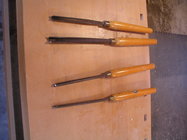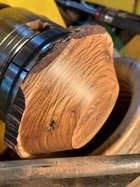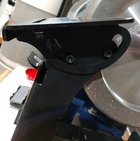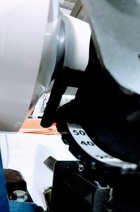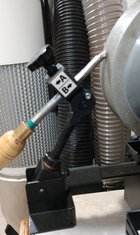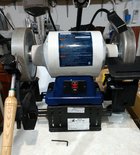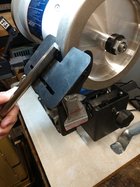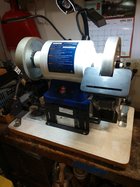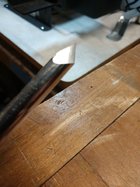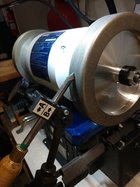I dont have one of those little string type sharpness gages that are well accepted as the scientific measurement method. They essentially measure the amount of force required to cut the test string.We're all a little loose in using the term "sharp". It's not a precise term. Sometimes I'll run my thumbnail down an edge as a judgement of sharpness, that really isn't a good way to judge an edge's ability to cut.
For example, grind a neutral rake scraping tool on a precision grinding machine. Neutral rake having an included angle of the cutting edge of 90 degrees (a square corner) and assume the thumbnail test indicates its smooth. I measured my favorite kitchen knife with an included angle of less than 5 degrees. Which would be better choice for whittling on a stick of wood? This is an extreme example of how the included angle should be included in any description of the sharpness of cutting edge. The lower the included angle the better the cutting edge.
When I talk about carbide inserts as being "high positive" it refers to a large back rake angle combined with a front relief angle which means a low included angle. They're used in automated, production woodturning because they do so well cutting both with and against the grain without needing much sanding. And, of course, being carbide they hold up longer than HSS. The insert manufacturers don't give any information on the included angle and it's not easy to measure, my guess is between 25 to 35 degrees. By canting their inserts down Hunter tools effectively increases the included angle making them a little less aggressive in cutting.
The cutter geometry plays a part too. The 30 degree diamond inserts shown in my previous posting are a factor too with a relatively small length of cutting edge removing material as oppose to a round insert.
I look at Hunter tools as a first big step forward in lathe tools.
So what choice do you make, wanting to rotate an insert to a new edge every so many hours or grinding a new edge every 15 minutes?
And, I still believe a carbide insert factory honed to mirror finish on a precision grinding machine using a 6,000 grit abrasive will have a better edge than a hand held HSS on a low budget Chinese bench grinder with a 180 grit CBN wheel.
What I do have is experience cutting the same piece of wood with carbide (flat and cupped cutters) and hss tools in the same type of cut. My hands are not instrumented, but they are capable of determining the carbide requires more force than the hss (new sharp edge).
The hunter style bowl gouge tools dont cut nearly as easily as my 60 deg hss gouge in a push cut, and my 40 deg hss gouge cuts even easier.
For hollowing I use a Jamieson system, and have the hunter cupped carbide cutter, which is tilted at ~45 deg. The holder also can use 1/4” square hss bits. It easy to tell which cutter uses less force when the cutter is 10 or 12 inches off the tool rest. When hollowing gnarly wood at depth, the hss cutter has significantly less reactionary force (cuts easier) vs the canted carbide cutter.

